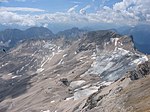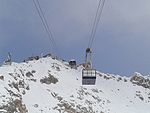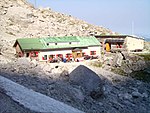Wetterspitzen

The Wetterspitzen are three of the rocky peaks on a mountain ridge in the Wetterstein mountains in the central part of the Eastern Alps in Germany. They lie two kilometres, as the crow flies, southwest of Germany's highest peak, the Zugspitze, on the border between the Austrian province of Tyrol and the German state of Bavaria. The Wetterspitzen form the southwest perimeter of the Zugspitze ledge (Zugspitzplatt); below and to the east is the ski region on the Schneeferner with its research station, the Schneefernerhaus. The three peaks are the: Northern Wetterspitze (Nördliche Wetterspitze) - 2,746 metres (9,009 ft) high; Southern or Middle Wetterspitze (Südliche (Mittlere) Wetterspitze) - 2,750 metres (9,020 ft) high; Eastern Wetterspitze (Östliche Wetterspitze) - 2,668 metres (8,753 ft) high.
Excerpt from the Wikipedia article Wetterspitzen (License: CC BY-SA 3.0, Authors, Images).Wetterspitzen
Gemeinde Ehrwald
Geographical coordinates (GPS) Address Nearby Places Show on map
Geographical coordinates (GPS)
| Latitude | Longitude |
|---|---|
| N 47.400277777778 ° | E 10.97 ° |
Address
Kanonenrohr
6632 Gemeinde Ehrwald
Tyrol, Austria
Open on Google Maps










